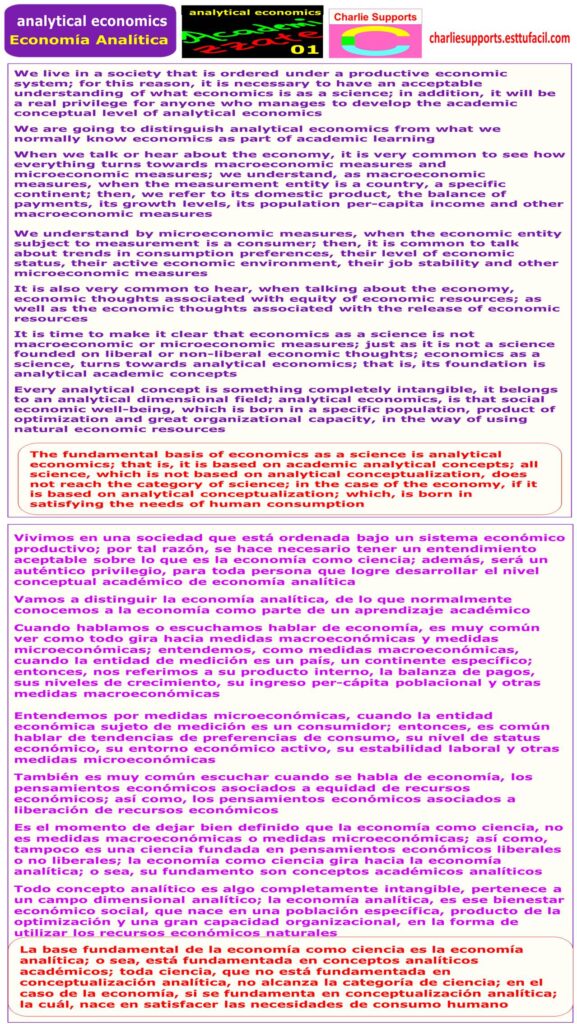
We live in a society that is ordered under a productive economic system; for this reason, it is necessary to have an acceptable understanding of what economics is as a science; in addition, it will be a real privilege for anyone who manages to develop the academic conceptual level of analytical economics
We are going to distinguish analytical economics from what we normally know economics as part of academic learning
When we talk or hear about the economy, it is very common to see how everything turns towards macroeconomic measures and microeconomic measures; we understand, as macroeconomic measures, when the measurement entity is a country, a specific continent; then, we refer to its domestic product, the balance of payments, its growth levels, its population per-capita income and other macroeconomic measures
We understand by microeconomic measures, when the economic entity subject to measurement is a consumer; then, it is common to talk about trends in consumption preferences, their level of economic status, their active economic environment, their job stability and other microeconomic measures
It is also very common to hear, when talking about the economy, economic thoughts associated with equity of economic resources; as well as the economic thoughts associated with the release of economic resources
It is time to make it clear that economics as a science is not macroeconomic or microeconomic measures; just as it is not a science founded on liberal or non-liberal economic thoughts; economics as a science, turns towards analytical economics; that is, its foundation is analytical academic concepts
Every analytical concept is something completely intangible, it belongs to an analytical dimensional field; analytical economics, is that social economic well-being, which is born in a specific population, product of optimization and great organizational capacity, in the way of using natural economic resources
The fundamental basis of economics as a science is analytical economics; that is, it is based on academic analytical concepts; all science, which is not based on analytical conceptualization, does not reach the category of science; in the case of the economy, if it is based on analytical conceptualization; which, is born in satisfying the needs of human consumption
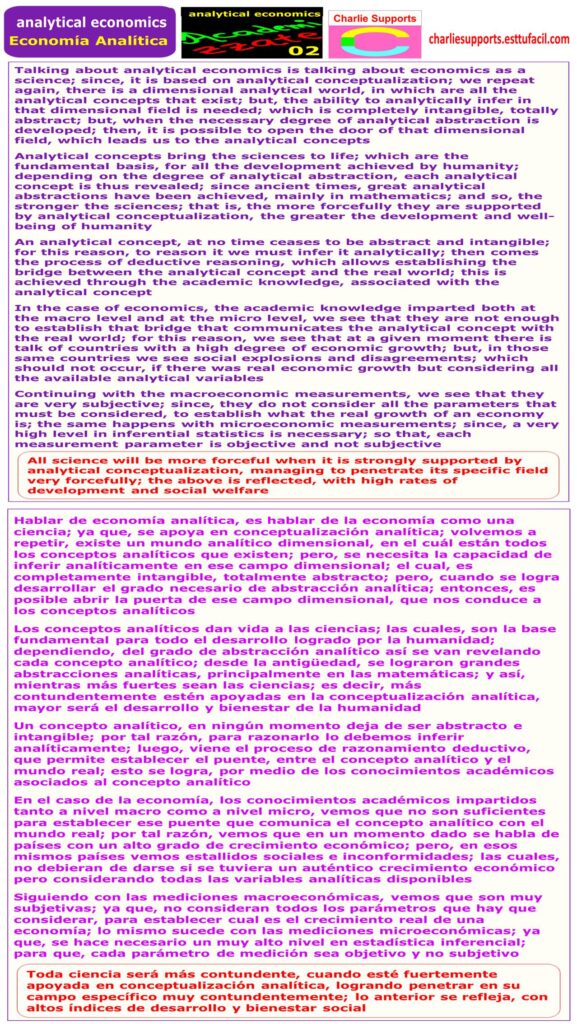
Talking about analytical economics is talking about economics as a science; since, it is based on analytical conceptualization; we repeat again, there is a dimensional analytical world, in which are all the analytical concepts that exist; but, the ability to analytically infer in that dimensional field is needed; which is completely intangible, totally abstract; but, when the necessary degree of analytical abstraction is developed; then, it is possible to open the door of that dimensional field, which leads us to the analytical concepts
Analytical concepts bring the sciences to life; which are the fundamental basis, for all the development achieved by humanity; depending on the degree of analytical abstraction, each analytical concept is thus revealed; since ancient times, great analytical abstractions have been achieved, mainly in mathematics; and so, the stronger the sciences; that is, the more forcefully they are supported by analytical conceptualization, the greater the development and well-being of humanity
An analytical concept, at no time ceases to be abstract and intangible; for this reason, to reason it we must infer it analytically; then comes the process of deductive reasoning, which allows establishing the bridge between the analytical concept and the real world; this is achieved through the academic knowledge, associated with the analytical concept
In the case of economics, the academic knowledge imparted both at the macro level and at the micro level, we see that they are not enough to establish that bridge that communicates the analytical concept with the real world; for this reason, we see that at a given moment there is talk of countries with a high degree of economic growth; but, in those same countries we see social explosions and disagreements; which should not occur, if there was real economic growth but considering all the available analytical variables
Continuing with the macroeconomic measurements, we see that they are very subjective; since, they do not consider all the parameters that must be considered, to establish what the real growth of an economy is; the same happens with microeconomic measurements; since, a very high level in inferential statistics is necessary; so that, each measurement parameter is objective and not subjective
All science will be more forceful when it is strongly supported by analytical conceptualization, managing to penetrate its specific field very forcefully; the above is reflected, with high rates of development and social welfare
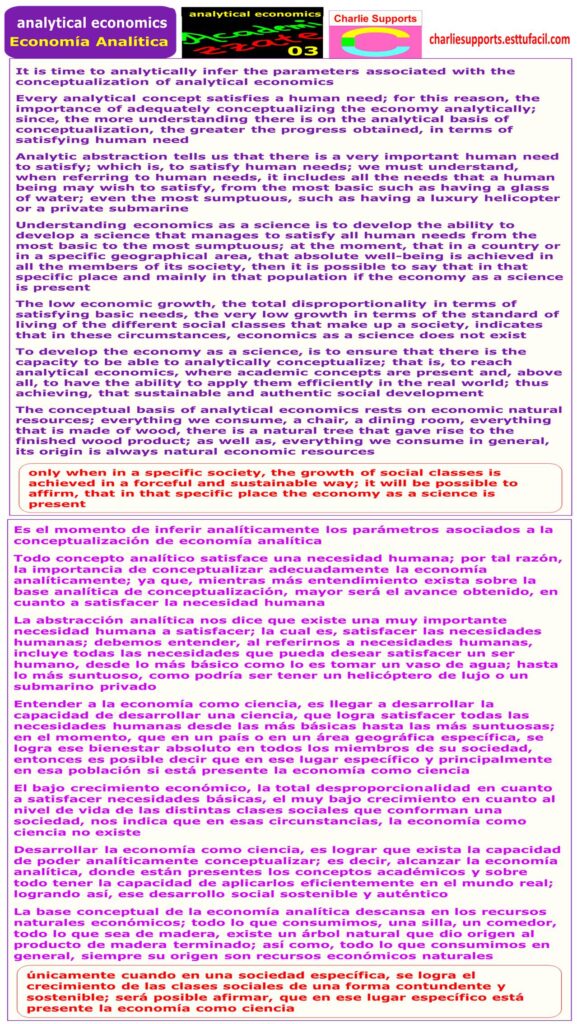
It is time to analytically infer the parameters associated with the conceptualization of analytical economics
Every analytical concept satisfies a human need; for this reason, the importance of adequately conceptualizing the economy analytically; since, the more understanding there is on the analytical basis of conceptualization, the greater the progress obtained, in terms of satisfying human need
Analytic abstraction tells us that there is a very important human need to satisfy; which is, to satisfy human needs; we must understand, when referring to human needs, it includes all the needs that a human being may wish to satisfy, from the most basic such as having a glass of water; even the most sumptuous, such as having a luxury helicopter or a private submarine
Understanding economics as a science is to develop the ability to develop a science that manages to satisfy all human needs from the most basic to the most sumptuous; at the moment, that in a country or in a specific geographical area, that absolute well-being is achieved in all the members of its society, then it is possible to say that in that specific place and mainly in that population if the economy as a science is present
The low economic growth, the total disproportionality in terms of satisfying basic needs, the very low growth in terms of the standard of living of the different social classes that make up a society, indicates that in these circumstances, economics as a science does not exist
To develop the economy as a science, is to ensure that there is the capacity to be able to analytically conceptualize; that is, to reach analytical economics, where academic concepts are present and, above all, to have the ability to apply them efficiently in the real world; thus achieving, that sustainable and authentic social development
The conceptual basis of analytical economics rests on economic natural resources; everything we consume, a chair, a dining room, everything that is made of wood, there is a natural tree that gave rise to the finished wood product; as well as, everything we consume in general, its origin is always natural economic resources
only when in a specific society, the growth of social classes is achieved in a forceful and sustainable way; it will be possible to affirm, that in that specific place the economy as a science is present
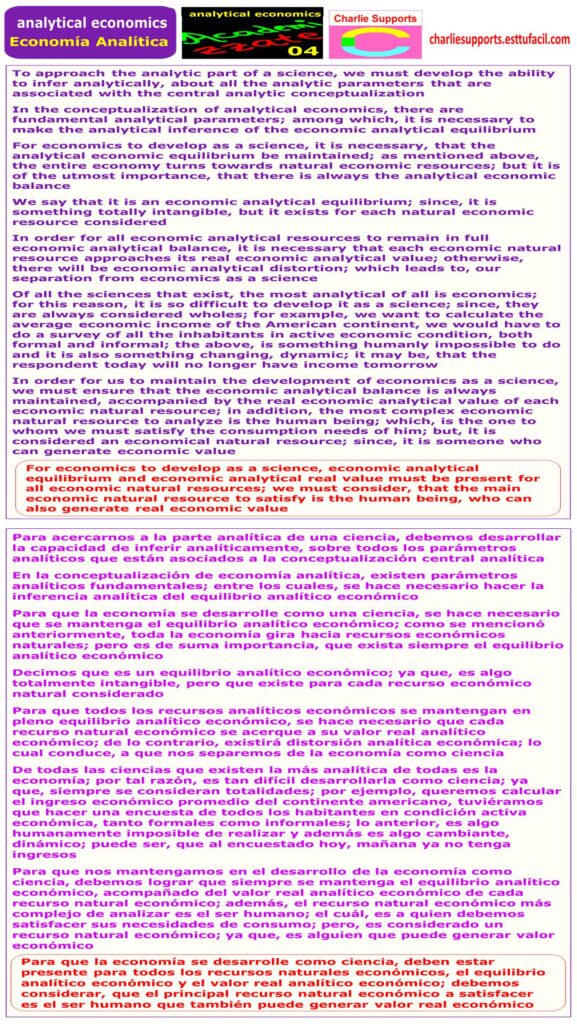
To approach the analytic part of a science, we must develop the ability to infer analytically, about all the analytic parameters that are associated with the central analytic conceptualization
In the conceptualization of analytical economics, there are fundamental analytical parameters; among which, it is necessary to make the analytical inference of the economic analytical equilibrium
For economics to develop as a science, it is necessary, that the analytical economic equilibrium be maintained; as mentioned above, the entire economy turns towards natural economic resources; but it is of the utmost importance, that there is always the analytical economic balance
We say that it is an economic analytical equilibrium; since, it is something totally intangible, but it exists for each natural economic resource considered
In order for all economic analytical resources to remain in full economic analytical balance, it is necessary that each economic natural resource approaches its real economic analytical value; otherwise, there will be economic analytical distortion; which leads to, our separation from economics as a science
Of all the sciences that exist, the most analytical of all is economics; for this reason, it is so difficult to develop it as a science; since, they are always considered wholes; for example, we want to calculate the average economic income of the American continent, we would have to do a survey of all the inhabitants in active economic condition, both formal and informal; the above, is something humanly impossible to do and it is also something changing, dynamic; it may be, that the respondent today will no longer have income tomorrow
In order for us to maintain the development of economics as a science, we must ensure that the economic analytical balance is always maintained, accompanied by the real economic analytical value of each economic natural resource; in addition, the most complex economic natural resource to analyze is the human being; which, is the one to whom we must satisfy the consumption needs of him; but, it is considered an economical natural resource; since, it is someone who can generate economic value
For economics to develop as a science, economic analytical equilibrium and economic analytical real value must be present for all economic natural resources; we must consider, that the main economic natural resource to satisfy is the human being, who can also generate real economic value
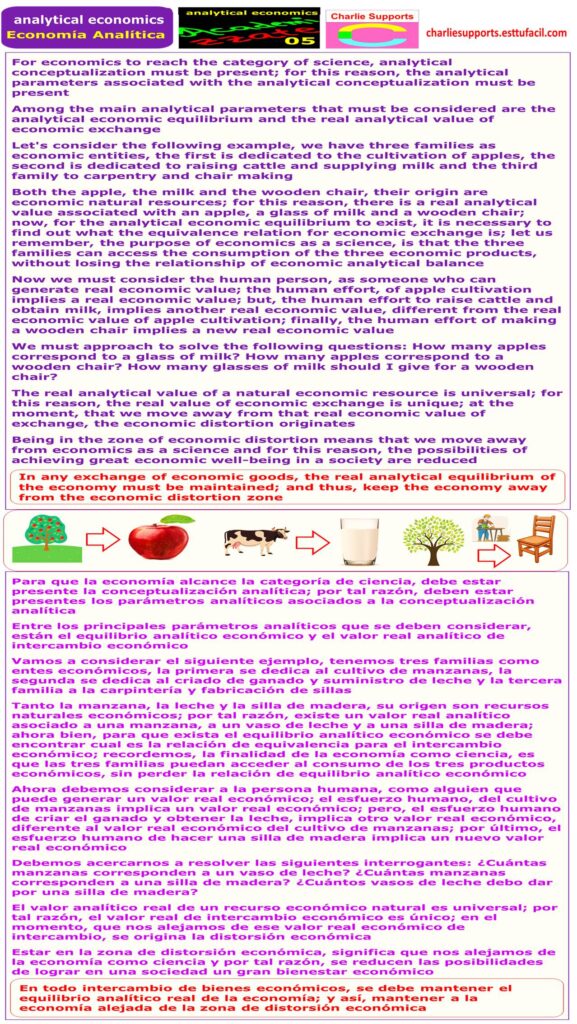
For economics to reach the category of science, analytical conceptualization must be present; for this reason, the analytical parameters associated with the analytical conceptualization must be present
Among the main analytical parameters that must be considered are the analytical economic equilibrium and the real analytical value of economic exchange
Let’s consider the following example, we have three families as economic entities, the first is dedicated to the cultivation of apples, the second is dedicated to raising cattle and supplying milk and the third family to carpentry and chair making
Both the apple, the milk and the wooden chair, their origin are economic natural resources; for this reason, there is a real analytical value associated with an apple, a glass of milk and a wooden chair; now, for the analytical economic equilibrium to exist, it is necessary to find out what the equivalence relation for economic exchange is; let us remember, the purpose of economics as a science, is that the three families can access the consumption of the three economic products, without losing the relationship of economic analytical balance
Now we must consider the human person, as someone who can generate real economic value; the human effort, of apple cultivation implies a real economic value; but, the human effort to raise cattle and obtain milk, implies another real economic value, different from the real economic value of apple cultivation; finally, the human effort of making a wooden chair implies a new real economic value
We must approach to solve the following questions: How many apples correspond to a glass of milk? How many apples correspond to a wooden chair? How many glasses of milk should I give for a wooden chair?
The real analytical value of a natural economic resource is universal; for this reason, the real value of economic exchange is unique; at the moment, that we move away from that real economic value of exchange, the economic distortion originates
Being in the zone of economic distortion means that we move away from economics as a science and for this reason, the possibilities of achieving great economic well-being in a society are reduced
In any exchange of economic goods, the real analytical equilibrium of the economy must be maintained; and thus, keep the economy away from the economic distortion zone
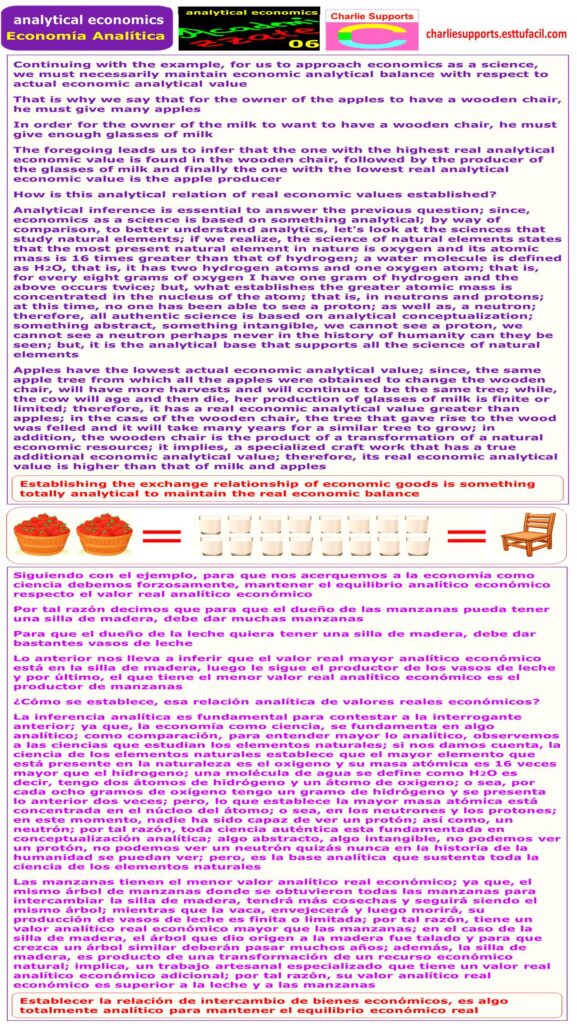
Continuing with the example, for us to approach economics as a science, we must necessarily maintain economic analytical balance with respect to actual economic analytical value
That is why we say that for the owner of the apples to have a wooden chair, he must give many apples
In order for the owner of the milk to want to have a wooden chair, he must give enough glasses of milk
The foregoing leads us to infer that the one with the highest real analytical economic value is found in the wooden chair, followed by the producer of the glasses of milk and finally the one with the lowest real analytical economic value is the apple producer
How is this analytical relation of real economic values established?
Analytical inference is essential to answer the previous question; since, economics as a science is based on something analytical; by way of comparison, to better understand analytics, let’s look at the sciences that study natural elements; if we realize, the science of natural elements states that the most present natural element in nature is oxygen and its atomic mass is 16 times greater than that of hydrogen; a water molecule is defined as H2O, that is, it has two hydrogen atoms and one oxygen atom; that is, for every eight grams of oxygen I have one gram of hydrogen and the above occurs twice; but, what establishes the greater atomic mass is concentrated in the nucleus of the atom; that is, in neutrons and protons; at this time, no one has been able to see a proton; as well as, a neutron; therefore, all authentic science is based on analytical conceptualization; something abstract, something intangible, we cannot see a proton, we cannot see a neutron perhaps never in the history of humanity can they be seen; but, it is the analytical base that supports all the science of natural elements
Apples have the lowest actual economic analytical value; since, the same apple tree from which all the apples were obtained to change the wooden chair, will have more harvests and will continue to be the same tree; while, the cow will age and then die, her production of glasses of milk is finite or limited; therefore, it has a real economic analytical value greater than apples; in the case of the wooden chair, the tree that gave rise to the wood was felled and it will take many years for a similar tree to grow; in addition, the wooden chair is the product of a transformation of a natural economic resource; it implies, a specialized craft work that has a true additional economic analytical value; therefore, its real economic analytical value is higher than that of milk and apples
Establishing the exchange relationship of economic goods is something totally analytical to maintain the real economic balance
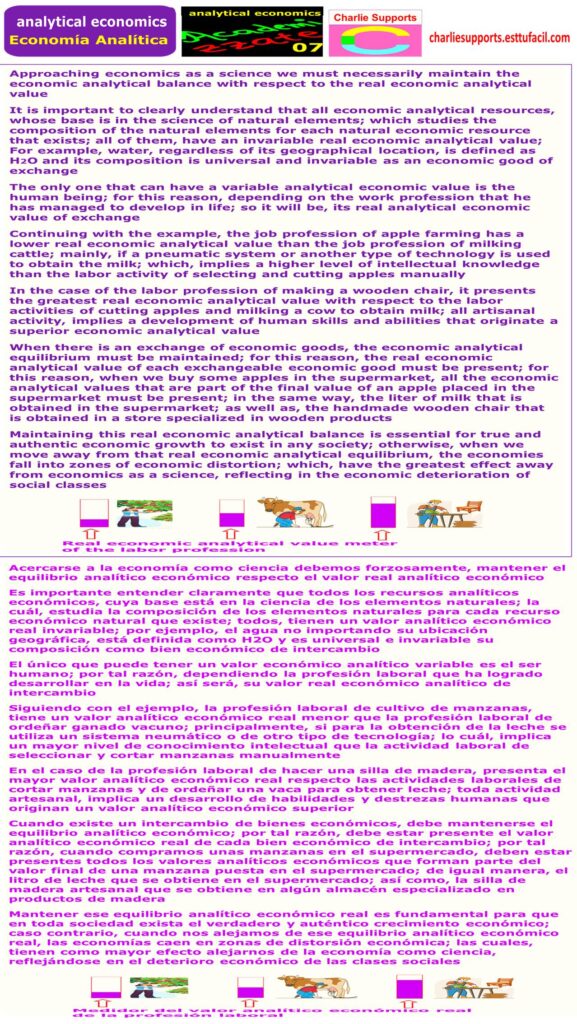
Approaching economics as a science we must necessarily maintain the economic analytical balance with respect to the real economic analytical value
It is important to clearly understand that all economic analytical resources, whose base is in the science of natural elements; which studies the composition of the natural elements for each natural economic resource that exists; all of them, have an invariable real economic analytical value; For example, water, regardless of its geographical location, is defined as H2O and its composition is universal and invariable as an economic good of exchange
The only one that can have a variable analytical economic value is the human being; for this reason, depending on the work profession that he has managed to develop in life; so it will be, its real analytical economic value of exchange
Continuing with the example, the job profession of apple farming has a lower real economic analytical value than the job profession of milking cattle; mainly, if a pneumatic system or another type of technology is used to obtain the milk; which, implies a higher level of intellectual knowledge than the labor activity of selecting and cutting apples manually
In the case of the labor profession of making a wooden chair, it presents the greatest real economic analytical value with respect to the labor activities of cutting apples and milking a cow to obtain milk; all artisanal activity, implies a development of human skills and abilities that originate a superior economic analytical value
When there is an exchange of economic goods, the economic analytical equilibrium must be maintained; for this reason, the real economic analytical value of each exchangeable economic good must be present; for this reason, when we buy some apples in the supermarket, all the economic analytical values that are part of the final value of an apple placed in the supermarket must be present; in the same way, the liter of milk that is obtained in the supermarket; as well as, the handmade wooden chair that is obtained in a store specialized in wooden products
Maintaining this real economic analytical balance is essential for true and authentic economic growth to exist in any society; otherwise, when we move away from that real economic analytical equilibrium, the economies fall into zones of economic distortion; which, have the greatest effect away from economics as a science, reflecting in the economic deterioration of social classes
Real economic analytical value meter
of the labor profession
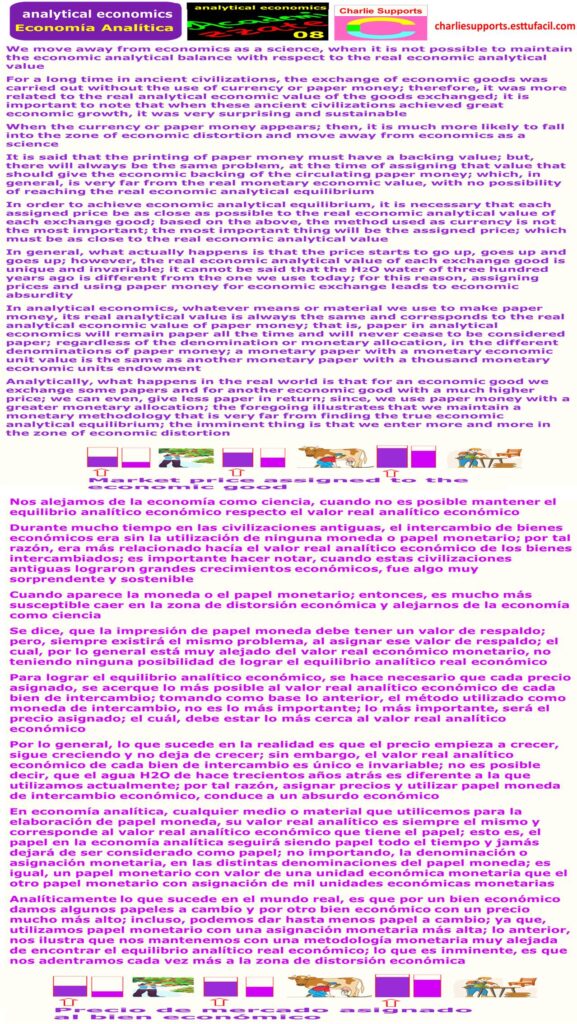
We move away from economics as a science, when it is not possible to maintain the economic analytical balance with respect to the real economic analytical value
For a long time in ancient civilizations, the exchange of economic goods was carried out without the use of currency or paper money; therefore, it was more related to the real analytical economic value of the goods exchanged; it is important to note that when these ancient civilizations achieved great economic growth, it was very surprising and sustainable
When the currency or paper money appears; then, it is much more likely to fall into the zone of economic distortion and move away from economics as a science
It is said that the printing of paper money must have a backing value; but, there will always be the same problem, at the time of assigning that value that should give the economic backing of the circulating paper money; which, in general, is very far from the real monetary economic value, with no possibility of reaching the real economic analytical equilibrium
In order to achieve economic analytical equilibrium, it is necessary that each assigned price be as close as possible to the real economic analytical value of each exchange good; based on the above, the method used as currency is not the most important; the most important thing will be the assigned price; which must be as close to the real economic analytical value
In general, what actually happens is that the price starts to go up, goes up and goes up; however, the real economic analytical value of each exchange good is unique and invariable; it cannot be said that the H2O water of three hundred years ago is different from the one we use today; for this reason, assigning prices and using paper money for economic exchange leads to economic absurdity
In analytical economics, whatever means or material we use to make paper money, its real analytical value is always the same and corresponds to the real analytical economic value of paper money; that is, paper in analytical economics will remain paper all the time and will never cease to be considered paper; regardless of the denomination or monetary allocation, in the different denominations of paper money; a monetary paper with a monetary economic unit value is the same as another monetary paper with a thousand monetary economic units endowment
Analytically, what happens in the real world is that for an economic good we exchange some papers and for another economic good with a much higher price; we can even, give less paper in return; since, we use paper money with a greater monetary allocation; the foregoing illustrates that we maintain a monetary methodology that is very far from finding the true economic analytical equilibrium; the imminent thing is that we enter more and more in the zone of economic distortion
Market price assigned to the economic good
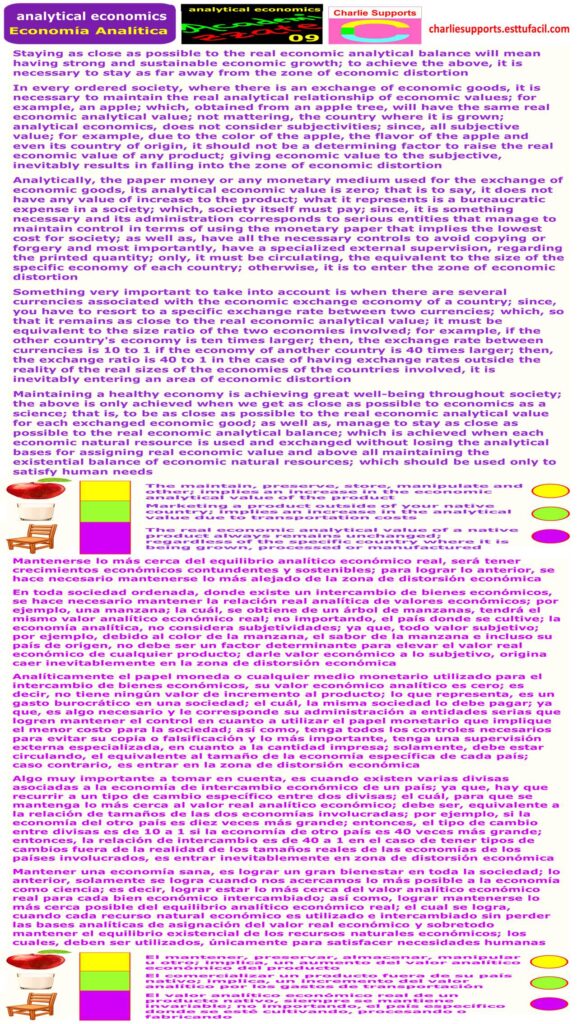
Staying as close as possible to the real economic analytical balance will mean having strong and sustainable economic growth; to achieve the above, it is necessary to stay as far away from the zone of economic distortion
In every ordered society, where there is an exchange of economic goods, it is necessary to maintain the real analytical relationship of economic values; for example, an apple; which, obtained from an apple tree, will have the same real economic analytical value; not mattering, the country where it is grown; analytical economics, does not consider subjectivities; since, all subjective value; for example, due to the color of the apple, the flavor of the apple and even its country of origin, it should not be a determining factor to raise the real economic value of any product; giving economic value to the subjective, inevitably results in falling into the zone of economic distortion
Analytically, the paper money or any monetary medium used for the exchange of economic goods, its analytical economic value is zero; that is to say, it does not have any value of increase to the product; what it represents is a bureaucratic expense in a society; which, society itself must pay; since, it is something necessary and its administration corresponds to serious entities that manage to maintain control in terms of using the monetary paper that implies the lowest cost for society; as well as, have all the necessary controls to avoid copying or forgery and most importantly, have a specialized external supervision, regarding the printed quantity; only, it must be circulating, the equivalent to the size of the specific economy of each country; otherwise, it is to enter the zone of economic distortion
Something very important to take into account is when there are several currencies associated with the economic exchange economy of a country; since, you have to resort to a specific exchange rate between two currencies; which, so that it remains as close to the real economic analytical value; it must be equivalent to the size ratio of the two economies involved; for example, if the other country’s economy is ten times larger; then, the exchange rate between currencies is 10 to 1 if the economy of another country is 40 times larger; then, the exchange ratio is 40 to 1 in the case of having exchange rates outside the reality of the real sizes of the economies of the countries involved, it is inevitably entering an area of economic distortion
Maintaining a healthy economy is achieving great well-being throughout society; the above is only achieved when we get as close as possible to economics as a science; that is, to be as close as possible to the real economic analytical value for each exchanged economic good; as well as, manage to stay as close as possible to the real economic analytical balance; which is achieved when each economic natural resource is used and exchanged without losing the analytical bases for assigning real economic value and above all maintaining the existential balance of economic natural resources; which should be used only to satisfy human needs
The maintain, preserve, store, manipulate and other; implies an increase in the economic analytical value of the product
Marketing a product outside of your native country; implies an increase in the analytical value due to transportation costs
The real economic analytical value of a native product always remains unchanged; regardless of the specific country where it is being grown, processed or manufactured
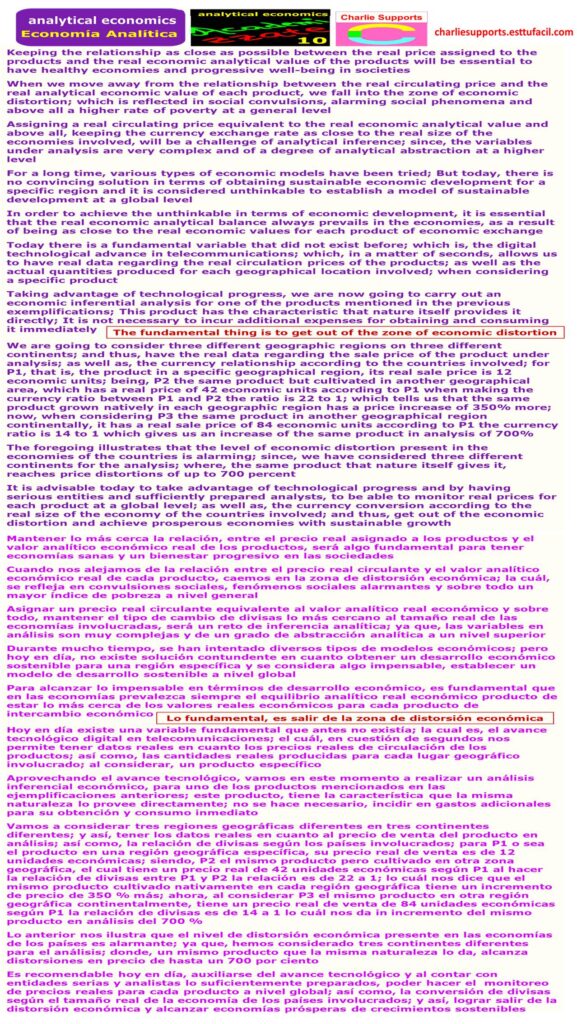
Keeping the relationship as close as possible between the real price assigned to the products and the real economic analytical value of the products will be essential to have healthy economies and progressive well-being in societies
When we move away from the relationship between the real circulating price and the real analytical economic value of each product, we fall into the zone of economic distortion; which is reflected in social convulsions, alarming social phenomena and above all a higher rate of poverty at a general level
Assigning a real circulating price equivalent to the real economic analytical value and above all, keeping the currency exchange rate as close to the real size of the economies involved, will be a challenge of analytical inference; since, the variables under analysis are very complex and of a degree of analytical abstraction at a higher level
For a long time, various types of economic models have been tried; But today, there is no convincing solution in terms of obtaining sustainable economic development for a specific region and it is considered unthinkable to establish a model of sustainable development at a global level
In order to achieve the unthinkable in terms of economic development, it is essential that the real economic analytical balance always prevails in the economies, as a result of being as close to the real economic values for each product of economic exchange
Today there is a fundamental variable that did not exist before; which is, the digital technological advance in telecommunications; which, in a matter of seconds, allows us to have real data regarding the real circulation prices of the products; as well as the actual quantities produced for each geographical location involved; when considering a specific product
Taking advantage of technological progress, we are now going to carry out an economic inferential analysis for one of the products mentioned in the previous exemplifications; This product has the characteristic that nature itself provides it directly; It is not necessary to incur additional expenses for obtaining and consuming it immediately
We are going to consider three different geographic regions on three different continents; and thus, have the real data regarding the sale price of the product under analysis; as well as, the currency relationship according to the countries involved; for P1, that is, the product in a specific geographical region, its real sale price is 12 economic units; being, P2 the same product but cultivated in another geographical area, which has a real price of 42 economic units according to P1 when making the currency ratio between P1 and P2 the ratio is 22 to 1; which tells us that the same product grown natively in each geographic region has a price increase of 350% more; now, when considering P3 the same product in another geographical region continentally, it has a real sale price of 84 economic units according to P1 the currency ratio is 14 to 1 which gives us an increase of the same product in analysis of 700%
The foregoing illustrates that the level of economic distortion present in the economies of the countries is alarming; since, we have considered three different continents for the analysis; where, the same product that nature itself gives it, reaches price distortions of up to 700 percent
It is advisable today to take advantage of technological progress and by having serious entities and sufficiently prepared analysts, to be able to monitor real prices for each product at a global level; as well as, the currency conversion according to the real size of the economy of the countries involved; and thus, get out of the economic distortion and achieve prosperous economies with sustainable growth
The fundamental thing is to get out of the zone of economic distortion